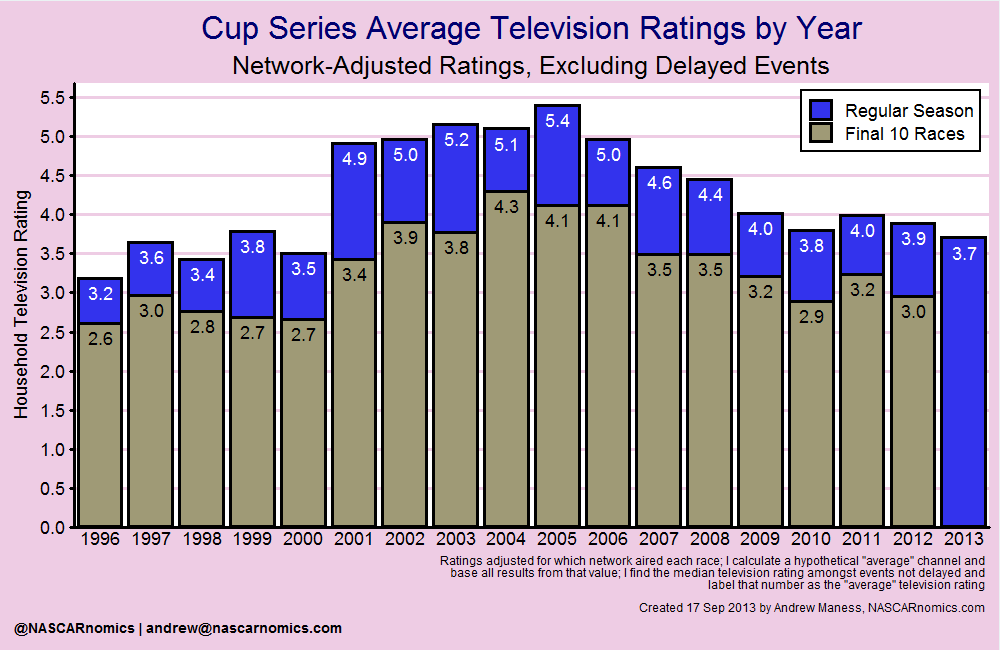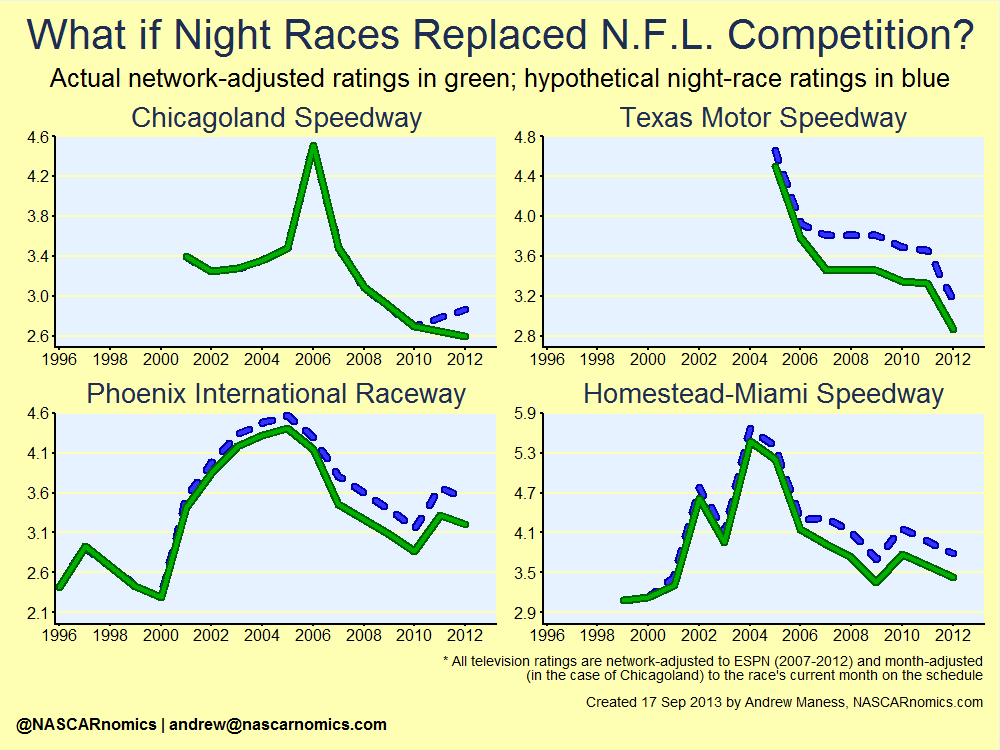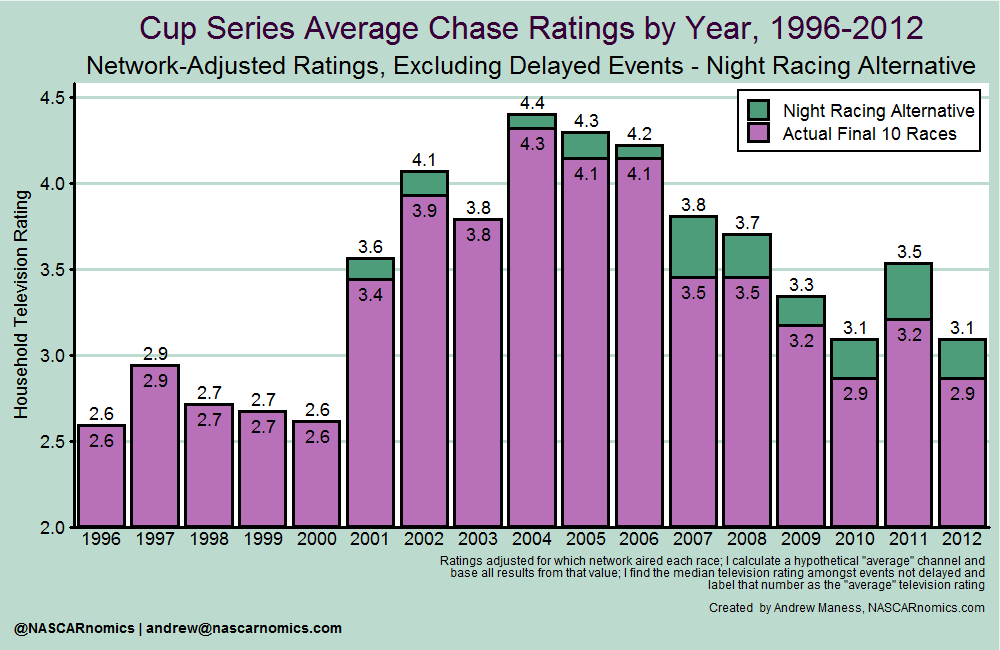The Chase, NFL, and Night Racing…
[NOTE: There are a lot of fun and interesting research pieces that will be posted in the coming weeks. Cup Series attendance. Grand National Series attendance. The Dale, Jr., Effect. Scheduling changes. Please be patient. Good research takes time. As always, you can forward to me your questions, critiques, and suggestions to and .]
I’ve written extensively about the Chase, the National Football League, and night racing for NASCAR’s premier series. I provide a link to each essay and briefly explain my findings. Here’s what you need to know about each:
-
“The Chase” has had no material effect on NASCAR’s television audience — for better or worse. The playoff system that was installed for the 2004 season and beyond demonstrates no relationship with an increase or decrease in television ratings. The following graph shows that the final ten races of each season have undergone similar peaks and valleys as the remaining balance of the schedule, regardless of which points system is used:

-
The National Football League’s growing popularity has become a nuisance in NASCAR’s pursuit to augment viewership toward the end of the year. While the two co-existed in the 1990s, professional football’s “boom” in ratings and attendance over the past decade has put a dent in the Cup Series’ endeavors:

-
The proliferation of night racing in the Cup Series has had an adverse affect on NASCAR’s television ratings. This is a tough situation for the sanctioning body — attendance tends to increase when races start in twilight or at night, but the home audience decreases by roughly 11%. If NASCAR continued traditional night-time events at Charlotte, Richmond, and Bristol; and ran all other races during the day, ratings would perform consistently better over time:

So what do the NFL and night racing have to do with the Chase? A lot, actually. In recent years, going head-to-head with professional football has eroded NASCAR’s ratings by over 22% in the fall. And while night racing tends to diminish the Cup Series’ audience as well, it actually performs much better on television than a race that airs directly against the NFL. I plot four examples that could benefit from a Saturday night race toward the end of the season. The dotted blue line lists the hypothetical television rating the track would receive in prime-time, while the green line represents the actual household audience the race garnered against a slate of professional football games:  Certainly, ESPN prefers showing some NASCAR races against the NFL because the Cup Series provides a viable viewership alternative football games on FOX and CBS. The positive aspect of moving an extra race or two to Saturday night in the fall, however, is that relatively more people will tune-in — both at home and at the weekend’s venue. That’s good for sponsors, fans, and tracks alike. Quantitatively, such an adjustment could net almost 600,000 more households’ watching the race. The NFL continues to expand its footprint throughout various media. Although that growth will slow at some point, NASCAR could employ the “blue ocean strategy” and migrate to Saturday evenings as the Chase heats-up and avoid competing with professional football entirely.
Certainly, ESPN prefers showing some NASCAR races against the NFL because the Cup Series provides a viable viewership alternative football games on FOX and CBS. The positive aspect of moving an extra race or two to Saturday night in the fall, however, is that relatively more people will tune-in — both at home and at the weekend’s venue. That’s good for sponsors, fans, and tracks alike. Quantitatively, such an adjustment could net almost 600,000 more households’ watching the race. The NFL continues to expand its footprint throughout various media. Although that growth will slow at some point, NASCAR could employ the “blue ocean strategy” and migrate to Saturday evenings as the Chase heats-up and avoid competing with professional football entirely.
And so what could the long term gains be for NASCAR’s top series? The Chase would certainly gather a larger audience per race:  The green bar shows how much the median rating of the final ten races would increase if three of the four candidates — Chicagoland, Homestead, Phoenix, and Texas — moved their races to Saturday evenings in the fall. Obviously, this is a hypothetical exercise, but night racing has attracted a larger audience historically compared to competition against the NFL.
The green bar shows how much the median rating of the final ten races would increase if three of the four candidates — Chicagoland, Homestead, Phoenix, and Texas — moved their races to Saturday evenings in the fall. Obviously, this is a hypothetical exercise, but night racing has attracted a larger audience historically compared to competition against the NFL.
What do you think? More night races? Do you prefer watching the NFL or NASCAR on a Sunday afternoon? What else could the sanctioning body do attract a larger audience in the fall?
Thanks for reading. I’m looking forward to your input, too.
